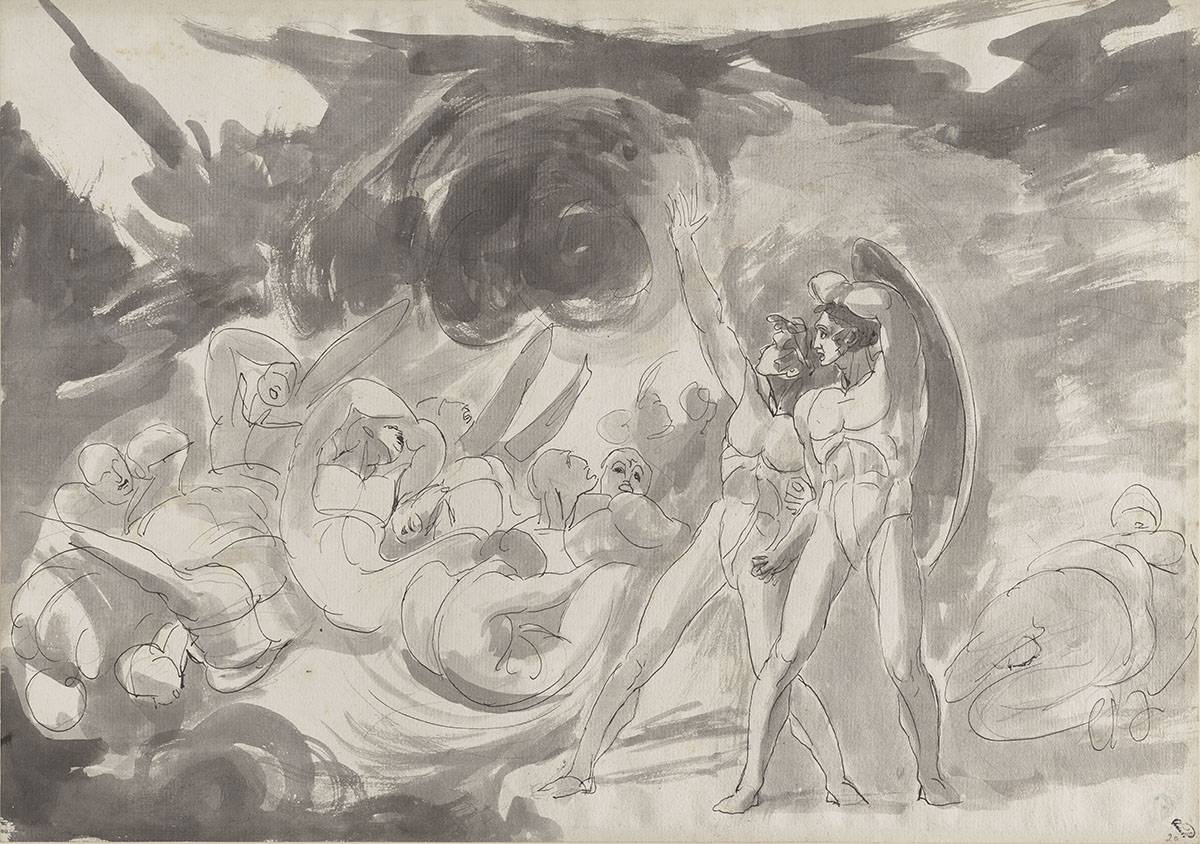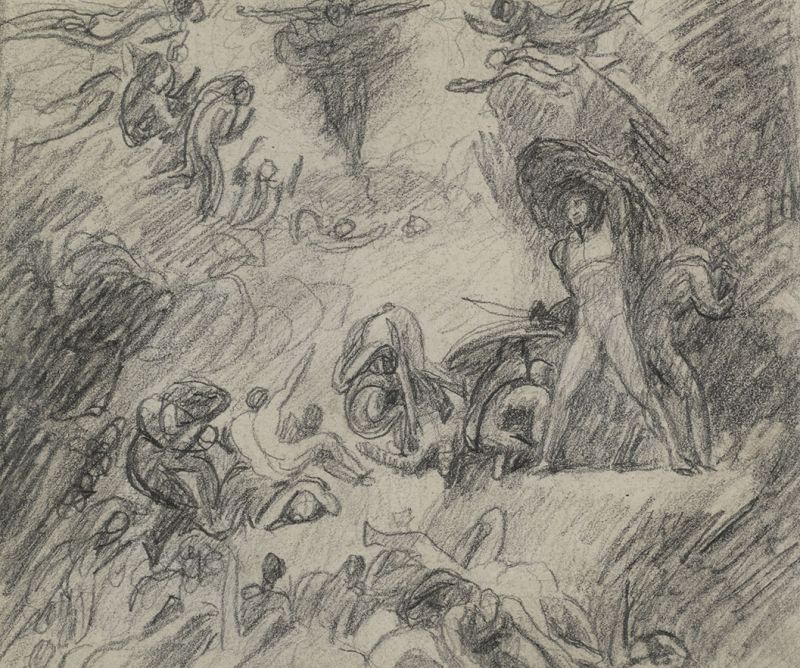This richly inked drawing points to Romney’s abiding interest in Milton’s Paradise Lost. The heroic male figures at the heart of the composition almost certainly depict Satan and one of his lieutenants, Mammon or Beelzebub; Romney habitually showed Satan as an athlete carrying a large shield, as here.
The drawing can be related to a number of sketchbook pages and a large highly worked sheet preserved in the Fitzwilliam Museum, Cambridge. Romney was a prolific draughtsman throughout his career, frequently revisiting his historical works, altering elements and compositional dynamics to produce the most compelling design. Romney’s historical work was largely separate from his portraiture. John Flaxman observed that Romney ‘was gifted with peculiar powers for historical and ideal painting, so his heart and soul were engaged in the pursuit of it, whenever he could extricate himself from the important business of portrait painting. It was his delight by day and study by night.’[1] This intensity of engagement with his historical texts is underscored by Romney’s son, in his biography, where he specifically observed that in his father’s copy of Milton: ‘which he was in the habit of studying, all the most striking and picturesque passages are marked, or underlined, by him; so that it may be regarded as a valuable printer’s book.’[2]
By the 1790s Romney was at the height of his powers as a painter. Romney combined his prodigious portrait practice with a relentless campaign of drawing, making hundreds of studies for historical compositions, many of which never came to fruition. This drawing dates from about 1790 at the moment Romney’s friend and biographer, William Hayley was commissioned by John and Josiah Boydell to write a new biography of Milton for a projected illustrated edition of Milton’s works; a follow-up to their Shakespeare Gallery. The Boydell’s scheme emerged as a rival project to one announced slightly earlier by the publisher Joseph Johnson to publish a new edition of Milton’s poems, with illustrations from Henry Fuseli. Unlike Fuseli, Romney was not commissioned to produce a series of illustrations to Milton, but he was clearly preoccupied with Milton and his work. In a letter to Hayley in 1791 Romney remarks ‘I have made a large composition from Milton, and I wish to keep my mind fixt to that work as much as possible.’ Whilst this letter may not relate specifically to this drawing, it suggests the level of engagement Romney had with Milton’s text.
In the present grandly worked drawing Romney develops the motif of Satan’s first words to the fallen angels. Paradise Lost begins in media res, Satan and the rebel angels having been defeated. Romney seems to have taken as his subject the moment after Satan has emerged from the fiery sea and stands regarding his fallen army – ‘thick as Autumnal leaves’ – it is a pivotal point, before Satan makes his rousing speech to the rebel angels. It is actually a moment that had been specifically suggested by Hayley as one ideal to be painted. Hayley in his own Poetical Epistle to an Eminent Painter published in 1778 and addressed to Romney had specifically suggested Paradise Lost as a possible subject-matter.
‘Let Milton’s self, conductor of the way,
Lead thy congenial spirit to portray
In Colours, like his verse, sublimely strong,
The scenes that blaze in his immortal song.’
Hayley goes on to suggest a possible subject for Romney:
‘Let thy bold Pencil more sublimely true,
Present his Arch Apostate to our view,
In worthier Semblance of infernal Pow’r,
And proudly standing like stately tow’r,
While his infernal mandate bids awake
His Legions, slumbering on the burning lake’[3]
Romney specifically shows Satan with: ‘his ponderous shield, Ethereal temper, massy, large and round, Behind him cast; the broad circumference Hung on his shoulders like the moon’, taking in the realities of his new domain. Romney shows Satan as a heroic athlete (as Hayley’s ‘stately tow’r’), Beelzebub standing next to him, arm stretched towards the darkness above them.
Worked rapidly in sweeping pen and ink lines, Romney has captured the broiling mass of fallen angels writhing in the fiery sea. This tumult of cursorily drawn histrionic figures with hollow, mask-like features contrast deliberately with the purposeful athletic form of Satan. Romney has elaborated and animated the sheet with rapid and expressive pools of black ink wash, imparting a frenzied kineticism to the scene.



